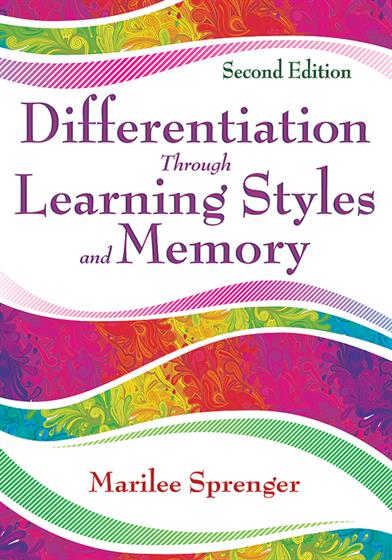Acknowledgments
About the Author
Prologue
The Way We Do the Things We Do
1. Environments for Learning
Reflect and Connect
What Is Differentiated Instruction?
Maslow's Hierarchy of Human Needs
Physiological Needs
Safety Needs
Need to Belong
Need for Esteem
Need for Self-Actualization
Classroom Environments
Physical Environment
An Attractive Environment
Lighting
Temperature
Color
Nutrition
Music
Humor
Water
Physical Safety
Social/Emotional Environment
Self-Awareness
Self-Management
Social Awareness
Relationship Management
Cognitive Environment
Predictability
Feedback
Novelty
Choice
Challenge
Reflection
The Stage Is Set
Different Strokes
Exit Card
2. Getting to Know Your Students: Learning Strengths
Reflect and Connect
Different Learners/Different Teachers
What Is a Learning Profile?
Attention
Patterns
Why Sensory Pathways?
Sensory Pathways
Visual
Auditory/Verbal
Kinesthetic/Tactile
Sensory Systems
Visual Memory Preference
Auditory/Verbal Memory Preference
Kinesthetic/Tactile Memory Preferences
Hands-On Learners
Whole Body Learners
Doodlers
Perceptual Patterns
The Need to Know
Reteaching
All Pathways Lead to Differentiation
Different Strokes
Exit Card
3. A Matter of Memory: Gaining a Better Understanding of How Students Remember
Reflect and Connect
Phases of Memory
Categorizing Memory
Sensory Memory
Immediate Memory
Active Working Memory
Long-Term Memory
Explicit Memory
How Do We Deal With Explicit Information?
Semantic Memory: Nothing but the Facts
Episodic Memory: Making the Invisible Visible
Implicit Memory
Conditioned Response: Lasting Memories
Procedural Memory: Just Do It!
Emotional Memory: If They Can Feel It - They'll Remember It!
Using Memory Systems to Access Prior Knowledge
Making Connections
Differentiation
Making Garpon Memorable
Automatic Memory
Emotional/Episodic Memory
Everyone Should Be Familiar With Garpon: Is That Your Final Answer?
Different Strokes
Exit Card
4. Differentiating Content, Process, and Product for the Visual Learner
Reflect and Connect
Do You Teach for Visual Memory?
Preassessment and the Visual Learner
Differentiation Design for Learners With Strong Visual Memory
Differentiating for Visual Memory and the Semantic System
Differentiating for Visual Memory and the Episodic System
Differentiating for Visual Memory and the Procedural System
Differentiating for Visual Memory and Conditioned Response
Differentiating for Visual Memory and the Emotional System
Visual Memory: I'll Show You What I Know!
Bloom's Taxonomy and the Visual Learner
Knowledge
Comprehension
Application
Analysis
Synthesis
Evaluation
A Note About Synthesis
Different Strokes
Exit Card
Visual Learner Snapshot
5. Differentiating Content, Process, and Product for the Auditory Learner
Reflect and Connect
Do You Teach for Auditory Memory?
Preassessment and the Auditory Learner
Differentiation Design for Learners With Strong Auditory Memory
Differentiating for Auditory Memory and the Semantic System
Differentiating for Auditory Memory and the Episodic System
Differentiating for Auditory Memory and the Procedural System
Differentiating for Auditory Memory and Conditioned Response
Differentiating for Auditory Memory and the Emotional System
Concentration and the Auditory Learner
Auditory Memory: I'll Tell It Like It Is!
Bloom's Taxonomy and the Auditory Learner
Knowledge
Comprehension
Application
Analysis
Synthesis
Evaluation
Different Strokes
Exit Card
Auditory Learner Snapshot
6. Differentiating Content, Process, and Product for the Kinesthetic Learner
Reflect and Connect
Do You Teach for Kinesthetic Memory?
Preassessment and the Kinesthetic Learner
Differentiation Design for Learners With Strong Kinesthetic Memory
Sameness Is Not Always Fairness
Differentiating for Kinesthetic Memory and the Semantic System
Differentiating for Kinesthetic Memory and the Episodic System
Differentiating for Kinesthetic Memory and the Procedural System
Differentiating for Kinesthetic Memory and Conditioned Response
Differentiating for Kinesthetic Memory and the Emotional System
Does It Really Make Any Difference?
Kinesthetic Memory: I'd Rather Do It Myself!
Bloom's Taxonomy and the Kinesthetic Learner
Knowledge
Comprehension
Application
Analysis
Synthesis
Evaluation
The Critter Connection
Different Strokes
Exit Card
Kinesthetic Learner Snapshot
7. Putting It All Together: Memory C.R.E.E.P.S. In!
Reflect and Connect
Identifying Learning Strengths
A Closer Look
Jeffrey
Elise
Jordan
Isaac
Micayla
Tobias
Lemar
Amos
Amanda
Calvin
An Eye Cue
Visual
Auditory
Kinesthetic
Remembering to Remember
Thinking About Thinking
Differentiated Instructional Strategies That Work for All Learners
Cubing
Jigsaw
Different Strokes
Exit Card
Learning and Memory Tips for Students
Epilogue
Bibliography
Index



